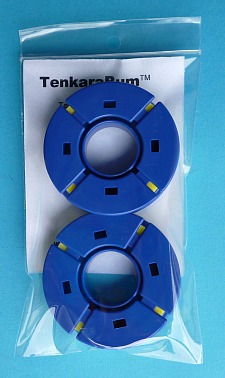Daiwa Kiyose 53M
Big Fish Tenkara
The Daiwa Kiyose 53M is a big water / big fish rod that will stand up to larger fish than any of the true tenkara rods available in the US or Japan.
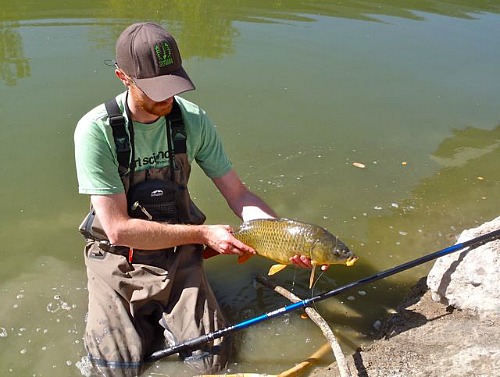 Photo copyright Tenkara Guides LLC. Used with permission.
Photo copyright Tenkara Guides LLC. Used with permission.Erik Ostrander was looking for a big water / big fish rod to use in the Green River One Fly competition and I was looking for someone who regularly catches bigger fish than I do to put the big rod through it's paces and see what it can handle.
He didn't hook any monster trout so he took it carp fishing. The rod that Erik is using in the video is a Daiwa Kiyose 53MF, which is a zoom rod that can be fished at 4.8m (15'8") or 5.3m (17'1") and is the next longer length than the Daiwa Kiyose 43MF. It seems to handle carp quite nicely. John Vetterli of the Tenkara Guides tells me they plan to offer guided carp fishing trips. As John says, "Just way too much fun." (John uses his Daiwa 43MF for carp and also for big trout in larger rivers.)
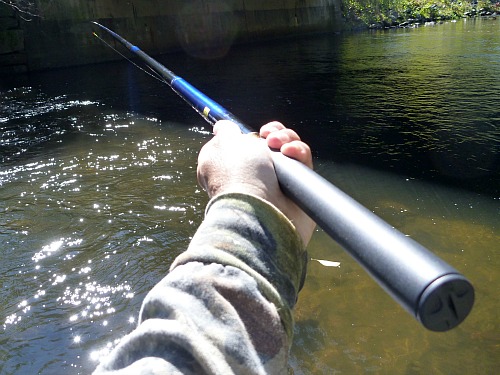
From the very first introduction of tenkara into the US, there have
been requests for rods that could handle bigger fish. About that time,
there was a video from Shimano making the rounds that showed a guy in
Alaska or Canada catching steelhead with a rod that looked a lot like a
tenkara rod on steroids. The fishing shown in the film was keiryu rather
than tenkara but whatever it is called, the desire to catch bigger fish
than any tenkara rod can handle never went away.
Quite some
time ago I realized that whether a fishing style is or isn't tenkara
(or pure tenkara) is of no particular importance if it is fun. It is
important only if you are trying to preserve purity or protect market
share. It is not important if you just want to go fishing.
Thus, I view
requests for big fish rods differently than someone who's primary emphasis is keeping tenkara true to the way it is practiced in Japan and the 8-12" fish they catch there. And when you consider that keiryu fishing in Japan is considerably more popular than tenkara fishing, there's really no point in sniffing "that's not tenkara."
Keiryu anglers in Japan do catch larger fish, but most of the very long and very strong Japanese keiryu rods are horrendously expensive. The Daiwa Kiyose 53M is pretty reasonably priced - within reach of someone who wants to give carp fishing a try - and certainly much less expensive than it would be to buy a new 8 or 9 weight fly rod, reel, and line. And if you get tired of carp fishing (is that possible?) you can always chase monster bass or huge trout.
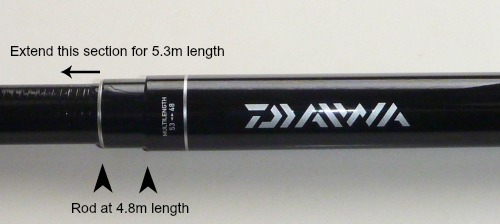
A nice feature of the Daiwa Kiyose 53M is that it can be fished at a fairly long 4.8 meter length, or at a very long 5.3 meter length. The length not only gives you increased casting distance, it also spreads the pull of a large fish over a very wide arc. The rod gives, but the gradually increasing resistance saps the fish's energy pretty quickly and can stop a fish better than you would expect.
One thing to keep in mind, though, is that the Daiwa Kiyose 53M is a
two handed rod. Even if you have forearms like Popeye, and even at the shorter 4.8m length, you will not want
to cast the 53M one handed. If the only rods you have used before are the extremely light seiryu rods, or even most tenkara rods, let me warn you - this rod is not the same. It is a big, beefy rod.
A couple years ago, I had an introduction to
two handed casting
in a session with Fred Krowchenko and Jerry Jahn at Spey Casting North
East. I don't know whether "speykara" will catch on, but it does widen
your horizons! Not only that, two handed casting makes even some of the 4.5m rods, like the Nissin 450ZX stiff and the Tenkara USA Ito, much more pleasant to use. If you think the Ito is a bit tip heavy at full extension, try it two handed. It tames the bear.
The question I get asked most about these rods is whether you can use one for steelhead. I have never caught a steelhead so I honestly don't know, but I have seen a photo of a steelhead caught on a less capable rod, so quite possibly so.If you want to try it, please understand the rod does not carry a warranty. (Just one more thing, if you do try it, take a camera. If you catch a steelhead on a Daiwa Kiyose 53M, I want a photo!)
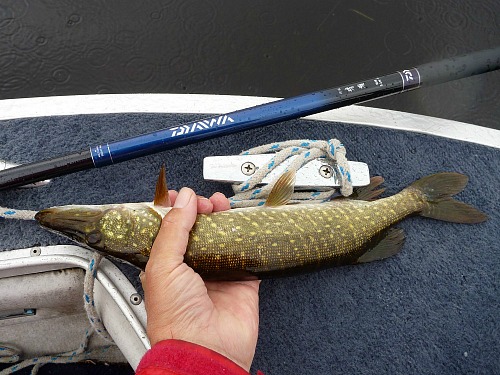 It's not a big pike, but it didn't even come close to taxing the rod.
It's not a big pike, but it didn't even come close to taxing the rod.Introduction to Keiryu
In addition to being an extremely capable rod for tenkara fishing for larger fish than any tenkara rod can handle, the Daiwa Kiyose 53M provides an excellent introduction to keiryu fishing. Keiryu anglers in Japan primarily use bait, often taken from under the rocks on the stream they are fishing, but I suspect most in the US will use bead head flies instead.
Even more than tenkara, the keiryu fishing style takes advantage of long rods to get unmatched drag free drifts. Keiryu anglers use shorter lines in relation to the rod than tenkara anglers - generally rod length or a bit shorter from rod tip to hook. That results in fishing with the line being closer to vertical, so there is less chance that the line could be affected by drag. That also means, though, that you need a longer rod to fish the same distance from where you are standing.
Although many keiyru rods are shorter than the 53M, they are used for pretty small streams. The shortest popular length for keiryu rods is 4.5m, just as 3.3m is the shortest popular length for tenkara rods. Rods of about 5.3m or 6.2m are more common for keiryu fishing.
Keiryu anglers use split shot to get their bait down near the bottom.
Because they cast the weight of the split shot rather than the
weight of the line, the line can be extremely light. From the standpoint
of getting natural presentations, the lighter the line the better.
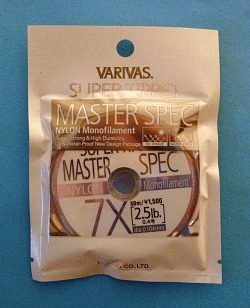
The Daiwa 53M is rated for lines from size .8 (5X) down to .4 (7X). In addition to being a primo big fish rod, it turns out the Daiwa 53M is also a primo ultralight rod. The rod itself isn't ultralight, but to be capable of fishing with 7X tippet from rod tip to fly? THAT is ultralight.
It doesn't take much weight in the form of split shot or bead head to be able cast a line that light. I was surprised that with a 6X line I was able to cast a size
20 Killer Bugger with a glass bead head and a size 10 micro fishing split shot. I have also found that with a 7X line I could cast with just the weight of a size 10 or 12 Killer Bug or Killer Bugger. The yarn absorbs enough water to give you just enough weight to cast. A small split shot or bead head is better, though.
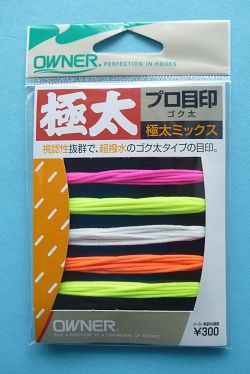
If you fish with tippet material for your casting line, you will want to use yarn markers so you can see the line and see the strikes. The markers make an invisible line extremely visible, even more so than a light tenkara line.
If you want to try the keiryu fishing style, using an extremely light line to achieve as drag-free a drift as possible, and a small split shot or bead head nymph to provide the weight for casting, I would recommend starting with the Daiwa Kiyose 53M.
This is truly an extremely versatile rod. It will handle a size 4 line
and 4X tippet when tenkara fishing for carp, size 3 line and 5X tippet when
tenkara fishing for trout and also protect a 7X line for keiryu fishing.
Long Rod - Short Line
I have written a bit about the long rod - short line technique for tenkara fishing, in which your tenkara line plus tippet is no longer than the rod's length and can be several feet shorter. I recently took that to an extreme, fishing with a rod just over 20' long and a line 4' shorter than the rod. I had my best day ever on that particular stream.
The drifts were among the best I have ever gotten and strike detection was excellent. With the Daiwa Kiyose 53M, a line plus tippet about 3' shorter than the rod should yield comparable results.
The main aspect of tenkara fishing that makes it more productive than western fly fishing is the combination of the long rod and light line, which allows you to keep most of your line off the water's surface, minimizing drag. To get those advantages and still fish farther away, you need a longer rod, not just a longer line. You will do much better with a 17' rod and a 14' line than you will with a 14' rod and 17' line.
Daiwa Kiyose 53M Features
The features of the Daiwa Kiyose 53M are very similar to those outlined on the Daiwa 43MF page.

The most noticeable feature of the Kiyose 53M is the fairly
wide blank that transitions into the grip with no steps or flare. The
grip section is a very effective non-skid coating that is reminiscent of wet/dry sandpaper. It has just enough texture to give you a positive grip whether it is wet or dry. The grip section is wide enough, the non-skid
is effective enough and the rod is light enough that I don't think you'll
miss the cork. You certainly won't miss the higher price that having a cork grip would require!
The grip screw cap is either a plastic or a composite, and comes with a slot so that it can be tightened with a coin, has a hole for ventilation and a rubber "O" ring to keep it from loosening when you are on the stream.
Instead of a tip plug, the Daiwa 53M comes with an external cap, similar to a Fuji rod cap, which provides a very secure closure and does allow you to keep your line attached when the rod is collapsed.
The rod comes with a nylon rod sock which is more than adequate to protect the finish from
scrapes and scratches. As with all the other Japanese rods, it comes
packaged in a plastic display case and neither has nor needs a hard
travel case.
The basic dimensions are:
Weight (with tip cap) - 4.6 oz
Weight (without cap) - 4.2 oz
Collapsed length (with cap) 21 3/8"
Length (minimum extension) 15'8"
Length (maximum extension) 17'1"
As with all the other Daiwa rods, replacement parts are available.
TenkaraBum Home > Tenkara Rods > Daiwa Kiyose 53M
“The bitterness of poor quality remains long after the sweetness of low price is forgotten” - Benjamin Franklin
"Be sure in casting, that your fly fall first into the water, for if the line fall first, it scares or frightens the fish..." -
Col. Robert Venables 1662
As age slows my pace, I will become more like the heron.
We've all had situations where seriously chewed up flies kept catching fish after fish after fish. It is no sin to tie flies that come off the vise looking seriously chewed up.
Warning:
The hooks are sharp.
The coffee's hot.
The fish are slippery when wet.
Beware of the Dogma
What's in stock?
Suntech Tenkarakyo 40F Tenkara Rods
Coming Soon
December
Kurenai II AR 30F
Kurenai II AR 33F
Kurenai II AR 39F
Nissin Oni Line size 3
Nissin Oni Line size 3.5
TenkaraBum 33
TenkaraBum 36
TenkaraBum 40
Medium Rod Case
January
Furaibo TF39
Furaibo TF39TA
Latest Pages
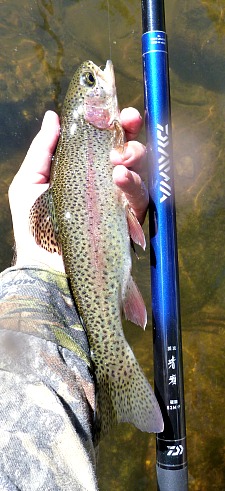 2013 model 53MF
2013 model 53MFEZ Keepers will not fit on the 53M. Tenkara Line Holders are recommended instead.
Landed a +20" Rainbow on the 53M today.
The rod is a beast.
Roger H, W. Virginia
If you enjoy spin fishing or baitcasting please visit my sister site Finesse-Fishing.com.



